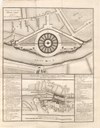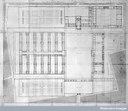Enlightened Models? Designs for New Hospital Buildings in the 18th century
Architect Bernard Poyet's design (left) vividly demonstrates the quandary between a mature inner-city location and daring Enlightenment ideas. The hospital is constructed as an amalgam of surveillance and utility architecture with the ventilation and aeration equipment as the most central facility. According to the ideas of contemporary medicine, it was supposed to prevent disease transmission within the hospital. In the end, the expertise of the surgeon Jacques Tenon became decisive, who, as a member of a royal commission, rejected Poyet's plan to propose several small hospitals instead of one large one. His Mémoires sur les hopitaux de Paris (1788) is based on extensive statistical surveys of the situation of all the hospitals in Paris. It is in this context that the idea of a hospital as a "machine à guérir" emerges.
Please click on the images to enlarge them.
Left: Bernard Poyet (1742–1824), Plan du nouvel Hotel Dieu, 1785; source: Cornell University Library, https://digital.library.cornell.edu/catalog/ss:549521#, public domain.
Center: Jacques Tenon (1724–1816), Plan of a Hospital for Sick and Pregnant Women, 1788, illustration in: Tenon, Jacques: Mémoires sur les hôpitaux de Paris, Paris 1788, plate XIV; source: Wellcome Library, London, http://wellcomeimages.org/indexplus/image/L0025476.html, public domain.
Right: Jacques Tenon (1724–1816), Plan of the Charité Hospital in Paris, 1788, illustration in: Tenon, Jacques: Mémoires sur les hôpitaux de Paris, Paris 1788, plate I; source: Wellcome Library, London, http://wellcomeimages.org/indexplus/image/L0033823.html, public domain.


